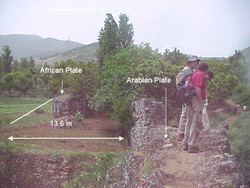Past earthquakes and their characteristics along the Dead Sea fault zone
Visible earthquake ruptures crossing various landscapes and archeological sites along the Dead Sea fault offer the opportunity to study seismic processes and damage distribution. The fault forms the Dead Sea as a pull-apart basin (and the lowest point on the continental earth) and extends south to the Red Sea and north up through coastal ranges of Lebanon and Syria ending in southern Turkey. The region also has a rich cultural heritage, abundant historical manuscripts and many archaeological sites. Scientists from the APAME project have studied pre-historical and historical earthquakes along the active fault and applied it to case studies. Using palaeoseismology and archaeoseismology aided with high-resolution radiocarbon dating, researchers can point to significant evidence for ancient earthquakes which resulted in significant damage. They produced a set of data concerning the occurrence of moderate-sized and large earthquakes with damage distribution along the northern and southern segments of the fault zone. Researchers also carried out an assessment of the long-term slip rate and related seismic energy release of the DSFZ. The APAME project included a critical evaluation of the seismic activity of the DSFZ before the present era, based on the archives on past civilisations. The work involved the assessment of the damage zone for each locality during historical events and an evaluation of the earthquake hazard and risk with modelling of collapsed buildings. The APAME project involved co-operation between European scientists and partners in the Middle East. The high population density and wealth of historical and cultural monuments existing within the region forms an exceptional source of information. The aim of the project was to implement seismic hazard models that can be applied to Europe. The results provide a better understanding and insight into seismic processes along active faults that may affect cultural sites and urban areas in Europe.







